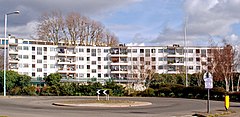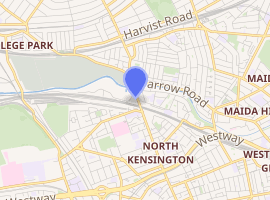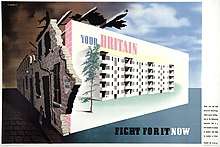Kensal House
Kensal House is a housing estate of two curved blocks of 68 housing association flats at the northern end of Ladbroke Grove, London, completed in 1937 and designed by the architect Maxwell Fry. It was the first modernist block in the UK designed to be occupied by the working class and on completion in 1937, was widely thought to be a prototype for modern living.
| Kensal House | |
|---|---|
 Kensal House in 2016 | |

| |
| General information | |
| Type | Housing association flats |
| Architectural style | Modernist |
| Location | Ladbroke Grove, London, England |
| Address | 1-68, Ladbroke Grove W10 |
| Coordinates | 51.5253°N 0.2151°W |
| Completed | 1937 |
| Client | Gas Light and Coke Company |
| Design and construction | |
| Architect | Maxwell Fry |
| Awards and prizes | Royal Gold Medal (1963) |
Listed Building – Grade II* | |
| Official name | Kensal House |
| Designated | 19 March 1981 |
| Reference no. | 1225244 |
Design
It was commissioned and financed by the Gas Light and Coke Company (GLCC) to provide 68 "working-class flats", housing 380 people.[1][2] It was the first modernist block in the UK designed for this purpose.[1] The project included a community centre, communal laundry, canteen and a nursery school.[3] The development was unusual in that there was no electricity provided, rather gas fires, coke fires, gas cookers, gas water heaters, and gas-powered irons.[4]
The project was designed by Maxwell Fry,[4] but was developed by a committee of five architects and the social reformer Elizabeth Denby, who had worked with Fry at the Peckham Pioneer Health Centre.[4] The GLCC wanted to show that a modern building could be run cheaply and powered safely by gas.[1] Fry wanted to create what he called an urban village, and he and Denby wanted to offer working people "healthier, happier, safer, and more fulfilling lives".[1] According to the Open University, "Kensal House marks the point in the story of British Modernist architecture when the social/political ideals of the early modernists come to the fore."[1] On completion in 1937 it was widely thought to be a prototype for modern living.[1]
Depictions

In 1937, the estate was the subject of an 11-minute documentary, Welcome to Kensal House, produced by the British Commercial Gas Association.[2][5] In 1940, Kensal House provided the cover image for James Maude Richards's An Introduction to Modern Architecture, published by Penguin Books.[5]
In 1942, Kensal House was featured prominently on a lithograph poster "Your Britain. Fight for It Now", designed by Abram Games, his second poster for the Army Bureau of Current Affairs.[3] The poster contrasts derelict slum housing with the clean, white and modern aesthetic of Kensal House.[3] Further wording on the poster reads: "Clean, airy and well planned dwellings make a great contribution to the Rehousing movement. This is a fine example of a block of workers' flats built in London in 1936."[6]
Recognition
Kensal House was a RIBA Royal Gold Medal winner in 1963.[4] It is Grade II* listed with Historic England,[7] as is the associated Kensal House Day Nursery.[8]
References
- "Kensal House". Open University. 26 November 2001. Retrieved 1 June 2020.
- "Welcome to Kensal House". BFI. Retrieved 30 May 2020.
- "'Your Britain. Fight For it Now', 1942". National Army Museum. Retrieved 1 June 2020.
- Priest, Isabelle (24 October 2018). "Watershed in housing history: Edwin Maxwell Fry". RIBA Journal. Retrieved 30 May 2020.
- Iain Boyd Whyte (19 December 2006). Man-Made Future: Planning, Education and Design in Mid-20th Century Britain. Routledge. pp. 171–172. ISBN 978-1-134-32519-1.
- "A modern block of flats contrasted with a row of unhealthy terrace houses. Colour lithograph after A. Games, 1942". Wellcome library. Retrieved 1 June 2020.
- "KENSAL HOUSE, Kensington and Chelsea – 1225244 | Historic England". historicengland.org.uk.
- "KENSAL HOUSE DAY NURSERY, Kensington and Chelsea – 1266444 | Historic England". historicengland.org.uk.